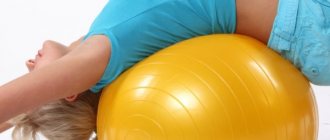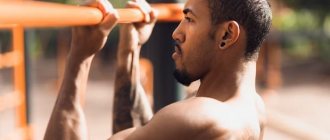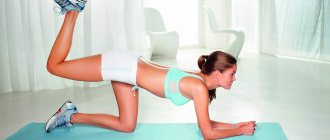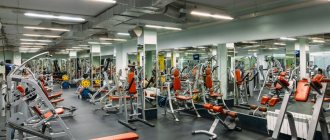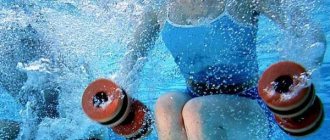Recently, the use of various fitness equipment has become popular both in the gym and at home. Dumbbells, a gymnastic mat, a tubular expander - every adherent of a sports lifestyle has these items. One of the most popular fitness tools is a fitball: it is inexpensive, can be found in any store, and is multifunctional. Together with World Class coach Alexander Karpov
Let’s figure out how a fitball can be useful, whether it helps you lose weight and whether it’s worth buying.
What is fitball?
Fitball is an elastic gymnastic ball, usually medium or large in size (from 45 to 95 cm), which is most often used during sports training. Previously, fitballs were used exclusively for medical purposes. Its creator is physical therapist Susan Klein-Vogelbach, who in the 50s of the last century began to use a large rubber ball in the process of rehabilitation of patients with cerebral palsy. Soon, thanks to the fact that exercise on a fitball contributed to a dramatic improvement in the condition of patients, it began to be used in the treatment of various pathologies, strengthening the vestibular system, and also during the recovery period after spinal injuries.
Now fitball is actively used not only in medicine, but also in the fitness industry. It has gained mass popularity due to its versatility. The exercises that can be performed on it are suitable for everyone. The classes are very gentle and do not require special physical training.
Photo: istockphoto.com
Benefits of exercising with a fitball
The biggest advantage of a fitball is balance! According to the National Academy of Sports Medicine (NASM), the body's major joints, such as the knees and hips, provide your body with mobility (the ability to move freely) or balance (the ability to maintain posture).
As a population suffering from muscle imbalances (thanks to our aforementioned stable world), the ability of these joints to maintain mobility or balance is compromised. According to NASM, tools like an exercise ball or bosu ball can help triggers improve balance. Other benefits of using a fitball include:
- Increased balance and mobility, which can reduce the risk of injury.
- Help develop proper movement patterns before resistance training, according to the American Council on Exercise
- Added muscle gain during exercise, according to NASM
How to use a fitball?
It’s not for nothing that we have already mentioned the versatility of the fitball. This is almost the only sports equipment, when used, the vestibular, motor, tactile and visual apparatuses are simultaneously activated. Depending on what exercises you perform, a fitball can help you solve many problems of the body: strengthen the muscles of the whole body, improve posture, get rid of spinal pain, develop the vestibular system and recover from injuries. You just need to choose a set of exercises that suits your goals. And fitness trainers are trying to find use for it in almost every area of training: from stretching to aerobics.
Fitness, yoga or Pilates: how to choose a mat for home workouts
Alexander:
It can be used for many types of workouts. As a rule, all exercises using a fitball are divided into two types: on a fitball and with a fitball. For example, bending the torso while lying on a fitball and squats with your back resting on a fitball. It can be used to teach the correct technique of squats, to complicate the coordination complexity of some exercises, to diversify the training process, and it is also suitable for people with health conditions, such as excess weight or back problems.
Photo: istockphoto.com
Back and arm workout
Exercises with a fitball, aimed at working out the whole body, help not only transform a girl’s figure, but also improve her health, for example, by strengthening the back muscles that support the spinal column.
If you have spinal diseases, before performing this complex, it is recommended to consult a doctor to determine whether there is a need to adjust the loads.
| Exercise with fitball | Technique for its implementation |
| Reverse boat |
|
| Hyperextension |
|
| Bridge |
During the exercise, sudden movements are not allowed. “Bridge” is not recommended for people with a low level of physical fitness and dysfunction of the vestibular apparatus. |
| Leg raises lying on a fitball |
This exercise requires great muscle strength, as well as ideal condition of the vestibular apparatus. It is recommended to perform it at the beginning of a block of exercises to strengthen the back and arms. |
Will exercising on a fitball help you lose weight?
Definitely yes. Even overweight people can perform exercises on a gymnastic ball, since the fitball relieves excess stress on the joints. Some sets of exercises take only 15-20 minutes, but make the whole body work at once. Almost all muscle groups are included, which will contribute to fat burning in problem areas. Thanks to high-speed exercises with a ball, the body is forced to expend more calories, which will also have a positive effect on weight loss. In addition, intense exercise helps speed up metabolism.
Alexander:
Any exercises, including those with a fitball, can help with weight loss if they correspond to the tasks implemented during the training and the level of training of the performer.
Photo: istockphoto.com
Upper body exercises
Exercises with a fitball for the whole body should equally involve both legs and arms. Upper muscle groups usually require more time to transform, so performing at least 2-3 arm exercises in each workout is a prerequisite for effective training.
| Exercise with fitball | Technique for its implementation |
| Fitball push-ups |
When performing this exercise, it is important to ensure that the abdominal muscles do not relax from the moment the load begins until it is completed. |
| Plank diagonally |
|
| Rolling the fitball forward |
|
| Reverse ball push-ups |
|
| Static bar |
|
How to choose the right fitball?
If you do not have the opportunity to visit the gym to use a fitball, you can buy sports equipment yourself and use it during home workouts. You should choose according to several criteria:
- Size:
it is worth starting from your height and arm length (the result of measuring your arm from the shoulder joint to the fingertips). If your height is less than 152 cm and your arm length is less than 55 cm, then a ball with a diameter of 45 cm will suit you; height from 155 to 169 cm and arm length from 56 to 65 cm - ball with a diameter of 55 cm; height from 170 to 185 cm and arm length from 66 to 75 cm - ball with a diameter of 65 cm; height more than 185 cm and arm length more than 75 cm - a ball with a diameter of more than 75 cm. - Appearance:
you can choose a smooth, massage (pimply or with pinches), with horns or an oval gymnastic ball. It all depends on your preferences. - Quality of the ball:
It is important that the ball is made of quality material, has an ABS system (or anti-blast system), is elastic, does not deflate and can withstand the weight of a person. - Color:
everything is individual here too. It’s worth choosing a color that will be pleasing to the eye and can lift your mood;)
Photo: istockphoto.com
Who is contraindicated for exercising on a fitball?
Alexander:
There are no specific contraindications; it all depends on the exercises chosen and level of training. Almost everyone can do trunk bends while lying on a fitball, regardless of their level of training and health status, but not everyone can do squats while standing on a fitball.
How to set up a gym at home? We select the necessary equipment with a trainer
And if you don’t take into account heavy activities that require special physical skills, for example, developed coordination, then almost everyone is allowed to perform basic exercises on a fitball. Children, elderly people, pregnant women - everyone can afford to train on a gymnastic ball. The main thing is to monitor the technique of doing the exercises so that the exercises are beneficial.
